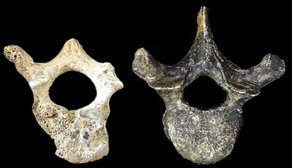If only bones could speak
The shape of fossil spine bones suggests that ancient human ancestors could speak.
By Emily Sohn
Language is one trait that separates people from other animals. Words give us the power to communicate complicated ideas, and this skill has taken us far.
No one knows exactly when our ancestors started talking, but new evidence suggests that it might have happened a long, long, long time ago. A set of bones found last year in central Asia shows that human ancestors living 1.8 million years ago were capable of speaking to one another.
 |
|
A recently discovered bone (left) from the spine of a human ancestor has a larger spinal cord canal than does a corresponding bone (right) from a skeleton that had been found in Kenya.
|
| Marc R. Meyer, University of Pennsylvania |
The fossils, which include several types of spine bones (or vertebrae), were found at a site called Dmanisi in the country of Georgia. They belonged to a human ancestor known as Homo erectus.
Anthropologists from the University of Pennsylvania in Philadelphia and the Georgian State Museum in Tbilisi compared the fossil bones with more than 2,200 vertebrae from people, chimpanzees, and gorillas.
The structure of the ancient human’s spine, they found, could have supported the muscles and nerves needed for speech. It’s impossible to prove that our ancient ancestors did in fact talk, but there was nothing that would have stopped them physically from discussing the weather.
The new finding counters previous interpretations of a 1.6-million-year-old skeleton found in Kenya in 1984. The backbone, which belonged to a 16-year-old boy, appeared too small to support the structures necessary for speech. Now, some scientists say that the boy had simply not grown correctly. With better nutrition, his spine would probably have been bigger.
Still, the final verdict isn’t in. Some scientists say that speech began only about 50,000 years ago, roughly 150,000 years after our species, Homo sapiens, emerged on Earth. Before then, they argue, neck bones were too short to allow a full range of speech sounds from the vocal tract.
However, many populations today, including Australian aborigines, have similarly short neck vertebrae, but that doesn’t keep these people from talking, say the authors of the new study.
If only the bones could speak!—E. Sohn
Going Deeper:
Bower, Bruce. 2006. Evolutionary back story: Thoroughly modern spine supported human ancestor. Science News 169(May 6):275-276. Available at http://www.sciencenews.org/articles/20060506/fob2.asp .
You can learn more about Homo erectus and the human family tree at www.mnh.si.edu/anthro/humanorigins/ha/a_tree.html (Smithsonian Museum of Natural History).







